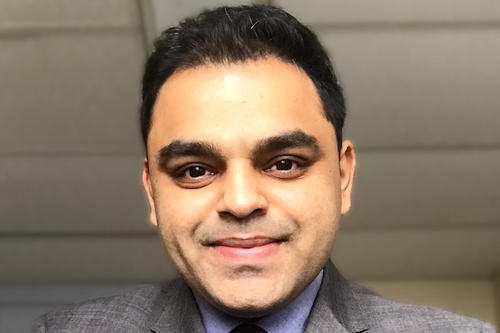
April is National Testicular Cancer Awareness Month. In 2019, the American Cancer Society estimates there will be 9,560 new cases of testicular cancer in the United States.
Arpit Rao, M.D., a testicular cancer expert with the Masonic Cancer Center and the University of Minnesota Medical School, answers questions on the symptoms, treatment and screening for testicular cancer.
Q: What is testicular cancer?
Dr. Rao: Testicular cancer is a cancer that starts in the testis, the male organ located in the groin and responsible for sperm production and production of male hormones such as testosterone.
Testicular cancer is a relatively less common cancer, affecting approximately one in 250 men throughout their lifetime. Despite this, over 9,500 men will be diagnosed and over 400 will die because of testicular cancer in the U.S. in 2019 alone. Testicular cancer predominantly affects young men with the average age being 33 years old at the time of diagnosis. Approximately five percent of cases occur in children and teens, and 10 percent in men over the age of 55.
Q: What are the symptoms of testicular cancer and how is it detected?
Dr. Rao: About 60 percent of men with testicular cancer never have symptoms and visit their doctor after they, or their partner, incidentally finds a lump or swelling in a testis. Dull ache or heaviness in the lower abdomen or scrotum is the presenting symptom in 30-40 percent of cases. In about 10 percent of cases, men have symptoms due to the spread of cancer such as significant unintentional weight loss; severe fatigue or a feeling of lack of energy; persistent shortness of breath; chest pain; cough; back pain; abdominal pain; and headaches or neurologic symptoms such as weakness or numbness of a part of the body.
Q: What are the treatment options for testicular cancer?
Dr. Rao: For most patients with testicular cancer, the first treatment is removal of the diseased testis with a surgery called radical orchiectomy. A biopsy of suspected testicular cancer is not necessary and could even be harmful as the biopsy needle could potentially spill the cancer cells into tiny blood vessels that can drain these cancer cells into the nearby lymph nodes. Radical orchiectomy should be performed by a surgeon with expertise in testicular cancer as a suboptimally performed surgery could result in the cancer left behind.
Some patients with early stage (stage 1 or 2) disease need a short duration of chemotherapy after surgery to kill any remaining cancer. Radiation can be used in place of chemotherapy in some of these patients depending on the type of cancer as well as other risk factors.
For patients with advanced stage (stage 3 or 4) testicular cancer, a longer course of chemotherapy, in addition to surgery to remove the diseased testicle, is considered the standard-of-care. Some patients may need participation in a clinical trial, or stem cell transplantation as well.
With adequate treatment, over 90 percent of testicular cancer patients will be cured. Survivorship—defined as the entire spectrum of supportive care services for a testicular cancer survivor to prevent, reduce and treat long-term complications of cancer treatments—is a critical part of the management of men with testicular cancer.
Q: What is the recommended age to screen for testicular cancer?
Dr. Rao: Unfortunately, there is no good screening test for testicular cancer. There are several reasons for this. One of them is that testicular cancer is uncommon, meaning lots of men will need to be checked to diagnose one man with cancer. However, even in healthy men, these tests can sometimes show abnormalities that may not have any clinical significance. This has the risk of unnecessary procedures as doctor and patient may become anxious regarding the possibility of missing a cancer.
Q: What are you doing to advance testicular cancer research?
Dr. Rao: Our core strength at the University of Minnesota is that we are one of the nation’s premier research institutions. For example, I spend about half of my time doing clinical research, which involves developing and running clinical trials of new treatments for patients with advanced cancers who do not have very many treatment options available. We currently have a clinical trial protocol for patients undergoing stem cell transplant for testicular cancer. The trial portfolio changes significantly each quarter and any interested patient can seek a referral from their doctor or refer themselves to come discuss these options with our genitourinary (genital and urinary organs) team.
I also lead the genitourinary biobanking program at the University of Minnesota, which enables us to collect and analyze cancer and blood specimens from any patient with a diagnosis of testicular cancer. The goal of this program is to allow our basic scientists to perform a comprehensive investigation of these cancers to find new ways to attack the cancer cells. It is safe to say that we are truly engaged in cutting-edge bench-to-bedside research to serve cancer patients in Minnesota.
Dr. Arpit Rao is an assistant professor in the University of Minnesota Medical School and Masonic Cancer Center member. His areas of expertise include testicular, prostate, kidney and bladder cancers.
About “Talking...with UMN”
“Talking...with UMN” is a resource whereby University of Minnesota faculty answer questions on current and other topics of general interest. Feel free to republish this content. If would like to schedule an interview with the faculty member or have topics you’d like the University of Minnesota to explore for future “Talking...with UMN,” please contact University Public Relations at [email protected].
- Categories:
- Health




